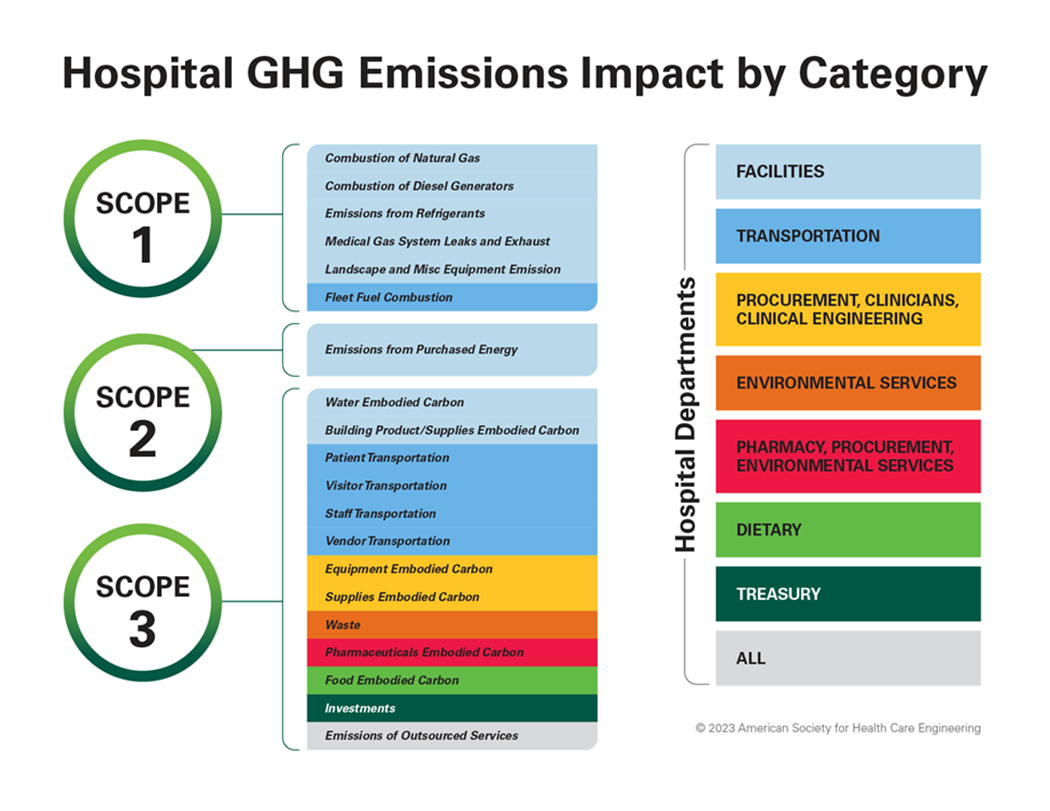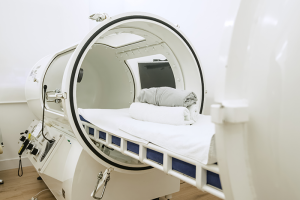Funding health care sustainability initiatives
Editor's note: This article provides an overview of several funding opportunities, including grants, incentives and tax credits, that exist to support health care organizations in their sustainability journeys. However, these financial tools can shift. Readers should thoroughly investigate the status of funding opportunities mentioned in this article before deciding to leverage them for current or future projects.

Several funding opportunities exist to help support the installation of on-site clean energy projects.
Image from Pexels
In today’s rapidly evolving health care landscape, sustainability has shifted from an operational afterthought to a cornerstone of resilience and financial performance. Health care facilities are not only addressing regulatory compliance but also responding to the expectations of increasingly environmentally conscious patients, staff and stakeholders. Prioritizing sustainable practices offers substantial benefits, from reducing operational costs to enhancing community trust and delivering improved patient care.
However, to achieve meaningful Scope 1 and Scope 2 decarbonization, health care leaders must actively seek out diverse opportunities that can financially support their sustainability initiatives. Federal and state resources offer a wealth of options, including tax credits and grants, designed to incentivize environmentally friendly practices. For example, the Energy Efficiency and Conservation Block Grant Program offers funding for projects aimed at reducing energy consumption, while the Inflation Reduction Act (IRA) provides different paths to significant savings for investments in renewable energy sources.
By familiarizing themselves with these funding streams, health care organizations can strategically plan their projects to align with available resources. This proactive approach not only maximizes financial support but also allows facilities to prioritize impactful measures that offer the greatest returns.
In addition to government funding, innovative financing solutions have emerged as viable pathways for health care organizations aiming to enhance their sustainability efforts.
Partnerships with private investors, nonprofit organizations and other stakeholders can provide the necessary capital for projects that may otherwise be cost-prohibitive. For instance, performance contracting and green bonds are two traditional debt financing options that allow health care facilities to undertake energy-efficiency upgrades without incurring upfront costs. Commercial property assessed clean energy (CPACE) financing and public-private-partnerships and private-private partnerships, both known as P3s, are other avenues that may be treated as “off-balance sheet” and have a reduced impact on credit ratings. A few health care entities have even created internal sustainable revolving loan funds to provide upfront capital and track and return savings to continue funding more projects.
These agreements not only ease financial pressures but also harmonize the goals of different stakeholders, promoting a cooperative effort to tackle climate change through shared sustainability objectives. Exploring these alternatives demonstrates the versatility of financing mechanisms available to health care organizations and underscores the importance of creative problem-solving in advancing sustainability goals.
Pioneering a greener future
Navigating the often complex funding landscape can be challenging for health care leaders, but understanding these options provides a pathway to achieve meaningful sustainability goals. Ultimately, the path to sustainability in health care goes beyond mere compliance; it represents a strategic investment that offers lasting advantages for both health care organizations and the communities they support.
Moreover, the integration of sustainability into health care practices not only addresses environmental concerns but also enhances operational efficiency. Hospitals that adopt sustainable practices often experience reduced energy costs, which can be reinvested in additional cost reduction opportunities, directed toward infrastructure capital renewal or redirected toward patient care and other essential services. Research indicates that hospitals with energy-efficient systems can reduce their energy costs by up to 30%, resulting in annual savings that can amount to millions of dollars. By prioritizing sustainability, health care organizations can create a more resilient infrastructure while simultaneously improving their bottom line.
Finally, as the conversation around health care sustainability continues to evolve, health care leaders have an opportunity to not only meet regulatory standards but to position their facilities as pioneers in the transition to a more sustainable health care system.
Innovations in telehealth, digital health technologies and sustainable supply chain practices present new opportunities for reducing environmental impact while enhancing patient care. By adopting innovative funding strategies, forming strategic partnerships and embracing new technologies, leaders can drive meaningful change benefitting their communities, organizations, team members and the patients they serve.
This article delves into the wide range of resources available to health care facilities seeking to adopt meaningful sustainability measures. It highlights federal and state tax credits, grants and other innovative financing options designed to support energy-efficiency initiatives. Additionally, the article emphasizes successful partnerships that have been formed to advance sustainability initiatives and how collaboration can drive progress.
Federal funding opportunities
The federal government offers several grants, credits and other resources to help offset the cost of energy-efficiency upgrades. The following list is not exhaustive, but it does serve as a starting point for organizations seeking federal support.
Inflation Reduction Act incentives // The IRA offers a range of incentives for organizations looking to invest in clean energy. This legislation allocates more than $369 billion in funding for energy and climate projects over the next decade, providing substantial opportunities for health care facilities. Key provisions include:
- Clean Electricity Investment Credit. Hospitals and health care facilities can receive a tax credit of up to 30% for installing renewable energy systems, such as solar panels or energy storage systems. This credit significantly offsets the upfront costs of renewable energy projects. Final rules and guidance are pending.
- Energy Efficient Commercial Buildings Tax Deduction (179D). This tax deduction has long been available to for-profit and government buildings. With the IRA, this credit has been expanded to include nonprofit health care facilities and retrofit projects. This deduction can be used for installing energy-efficient systems, such as heating, ventilating and air-conditioning systems (HVAC); lighting; and building envelope improvements. Currently valued at up to $5 per square foot (as of 2023), this deduction rewards projects that meet or exceed the energy-efficiency standards of ASHRAE 90.1, Energy Standard for Sites and Buildings Except Low-Rise Residential Buildings.

Tax credits can help to bring down the upfront costs of installing energy-efficient infrastructure upgrades.
Image courtesy of ASHE
Department of Energy (DOE) grants // The Department of Energy offers several grant opportunities aimed at promoting energy efficiency, electrification and renewable energy in commercial buildings, including hospitals. The DOE’s Office of State and Community Energy Program, for instance, provides states with funding to support energy-efficiency building initiatives and renewable energy projects. Additionally, the DOE’s Better Buildings initiative collaborates with hospitals and health care systems to promote energy efficiency and sustainability best practices, offering both technical assistance and financial resources.
One such resource is the Energy Efficiency and Conservation Block Grant Program. This program offers formula funding to state, local and tribal governments, which can be used to implement energy-efficiency and renewable energy projects. Health care facilities may collaborate with local governments to access these funds for community-scale projects.
Other federal-level resources // Administered by the Department of Agriculture, the Rural Energy for America Program provides grants and loan guarantees for renewable energy projects and energy-efficiency improvements. Though targeted at rural businesses, health care facilities in eligible rural areas can benefit. For instance, funds can support solar installations, high-efficiency HVAC systems and LED lighting upgrades.
The Greenhouse Gas Reduction Fund is another incentive that is managed by the Environmental Protection Agency, this fund provides grants to mobilize financing for clean energy projects, with a focus on low-income and disadvantaged communities. Health care facilities can work with lending organizations like green banks and community development financial institutions to access these resources.
State-level resources
State governments often provide their own incentives and other opportunities, complementing federal programs. Platforms like the Database of State Incentives for Renewables & Efficiency provide comprehensive listings of state and local incentives. These tools can help health care facilities identify programs that align with their sustainability goals. A few are listed below.
Renewable energy certificates (RECs) // In states with renewable portfolio standards, hospitals may earn or purchase RECs for using or generating renewable energy. These certificates can be sold to utilities or companies needing to meet renewable energy quotas.
Commercial property assessed clean energy // Many states offer CPACE financing, allowing health care facilities to finance energy-efficiency, renewable energy and water conservation projects through an assessment on their property taxes. This long-term financing can be transferred to the next building owner if the property is sold.
State-specific grants // States also offer direct grants to support sustainability projects. For example, California’s energy efficiency financing program provides low-interest loans to hospitals for energy-efficiency and sustainability projects, while New York’s NY-Sun program offers incentives for solar projects.
Technical support and energy audits // Many states include technical assistance as part of their energy-efficiency initiatives, helping health care facilities conduct energy audits and develop performance specifications.
Alternative financing options
Embarking on partnerships with third-party companies and vendors is another financing strategy that health care organizations can tap into. Often, these relationships come with the added benefit of minimizing financial risk and lowering upfront costs to the health care facility.
Energy service performance contracts (ESPCs) // ESPCs are agreements with third-party energy service companies to install and maintain energy-efficiency improvements in exchange for a portion of the cost savings. This allows health care facilities to fund upgrades without upfront capital investment, using the energy savings to pay for the project over time. ESPCs are particularly appealing for hospitals looking to minimize financial risk while improving energy efficiency.
Green bonds // Green bonds have gained traction as a financing tool for hospitals seeking to fund sustainability projects. These bonds, designated for environmentally friendly initiatives, can help facilities raise the necessary capital for clean energy, energy-efficient building systems and other sustainability measures. Green bonds often come with tax advantages and attract investors focused on sustainable initiatives.
Vendor partnerships and agreements // Health care facilities can explore vendor partnerships, especially through power purchase agreements (PPAs). In a PPA, a third party installs and maintains renewable energy systems (such as solar panels) on the facility’s property, and the hospital agrees to purchase the energy generated at a fixed rate. This arrangement lowers upfront costs for the health care facility while securing access to clean energy. Additionally, vendors of energy-efficient equipment may offer financial incentives, rebates or special pricing to support sustainability initiatives.
P3s include a range of potential solutions that seek to bring additional flexibility to public entities, but the concept is being expanded to other sectors with constrained access to capital, such as nonprofit health care. P3 projects have been successfully used for toll roads and parking garages but are increasingly finding their place in more traditional building infrastructure. P3 partnerships are typically long-term agreements (15 to 50 years) in which a private entity provides upfront capital in exchange for some form or share of a durable revenue stream that supports repayment over the term of the partnership.
Additional opportunities and considerations
Moving beyond the federal, state and alternative funding options that can be leveraged to support energy-efficiency projects, health care organizations should also look into rebate programs with their local utilities as well as the wide array of philanthropic organizations that elevate sustainability, clean energy and resiliency as core missions.
Utility rebates // Many utilities provide rebates to incentivize the adoption of energy-efficient technologies. Health care facilities can benefit significantly by collaborating with local utility companies to investigate available rebate programs. These programs often support upgrades to essential systems such as lighting, HVAC and building controls, helping to reduce operational costs. By taking advantage of these incentives, facilities can enhance energy efficiency and improve patient comfort. Furthermore, such investments not only lead to immediate financial savings but also contribute to long-term sustainability goals within the health care sector.
Nonprofit and foundation grants // Grant programs available to health care organizations include:
- The U.S. Energy Foundation. Provides grants to support clean energy initiatives and policies aimed at reducing greenhouse gas emissions.
- The Rockefeller Foundation. Focuses on sustainable development, including grants for projects that promote renewable energy and energy efficiency.
- The Kresge Foundation. Offers funding for climate resilience and sustainability projects, particularly in low-income communities.
- The William and Flora Hewlett Foundation. Supports initiatives that address climate change, including renewable energy projects and policy advocacy.
- The Doris Duke Charitable Foundation. Funds projects that advance sustainable building practices and energy efficiency in the arts and environment sectors.
- The Surdna Foundation. Provides grants for sustainable communities, focusing on reducing carbon emissions through innovative practices.
- The Bullitt Foundation. Supports initiatives that promote sustainable development and decarbonization in the Pacific Northwest.
- The Nathan Cummings Foundation. Offers funding for projects that address climate change and promote social justice.
- The Walton Family Foundation. Supports renewable energy projects and sustainability initiatives, particularly in education and community development.
- The ClimateWorks Foundation. Funds initiatives aimed at reducing global greenhouse gas emissions, with a focus on policy, innovation and investment.
Leveraging capital campaigns and philanthropy // Some health care facilities have successfully integrated sustainability initiatives into broader capital campaigns and fundraising efforts. Emphasizing the environmental and public health benefits of energy-efficiency projects can resonate with donors, particularly as community awareness of climate change grows. Philanthropy can help finance large-scale projects, such as solar installations or building retrofits, that may not qualify for traditional funding.

Capital campaigns and nonprofit foundations provide another source to fund public-facing sustainability projects, such as green roofs.
Image from Getty Images
Seizing sustainable opportunities
As health care facilities strive to achieve carbon neutrality and enhance energy efficiency, it’s essential that leaders explore diverse funding mechanisms to support their sustainability goals. Federal and state-level incentives, alternative financing options, vendor partnerships and utility rebates provide a comprehensive tool kit for securing the necessary capital.
By leveraging these resources, health care leaders can take actionable steps toward energy efficiency, creating sustainable facilities that reduce operational costs, enhance resilience and align with the field’s broader environmental goals.
Health care facilities leaders should remain proactive and stay informed about evolving policies and funding programs (see the Editor’s Note above). Sustainability funding is dynamic, with new incentives and regulations emerging regularly. By actively identifying and applying for available programs, leaders can ensure their facilities are positioned to benefit from financial support and stay ahead of regulatory requirements. Collaborating with energy consultants and legal experts can also help ensure that hospitals maximize available incentives and effectively implement their sustainability efforts.
In addition to government programs, partnerships with local utilities, nonprofits and private investors can further ease the financial burden of sustainability projects. It has become commonplace for successful health care organizations to turn to these collaborative efforts to reduce upfront costs and share the financial risks associated with major infrastructure changes. Through strategic partnerships and well-executed financing arrangements, health care facilities not only advance their environmental stewardship but also gain a competitive advantage by establishing themselves as leaders in sustainability within the health care field.
By embracing these resources and strategies, health care leaders can position their facilities for long-term success beyond Scope 1 and Scope 2 emissions. These efforts not only contribute to a sustainable health care sector but also establish a legacy of resilience and responsibility for future generations.
RELATED ARTICLE // Power purchase agreements: A low-risk path to renewable energy
Power purchase agreements (PPAs) offer health care facilities a strategic and financially viable way to transition to renewable energy. These long-term contracts allow organizations to purchase electricity generated from renewable sources, such as solar or wind, without requiring significant upfront capital investment. PPAs have become increasingly popular as health care organizations look for ways to decarbonize operations while maintaining financial flexibility.
Under a PPA, a third-party energy provider installs, owns and operates renewable energy infrastructure, such as solar panels or wind turbines, either on-site or off-site. The health care facility agrees to buy the electricity produced at a fixed rate over a specified period, usually ranging from 10 to 25 years. This agreement ensures predictable energy costs while transferring the responsibility for system installation, maintenance and performance to the energy provider.
There are several advantages to health care facilities when leveraging a PPA.
- No upfront costs. Health care facilities avoid the significant capital expenditure required to install renewable energy systems, making sustainability projects more accessible.
- Cost predictability. Fixed energy rates shield organizations from fluctuating utility prices, aiding long-term budget planning.
- Reduced carbon footprint. By sourcing renewable energy, hospitals can significantly lower greenhouse gas emissions, aligning with environmental and regulatory goals.
- Operational flexibility. The third party assumes system ownership and maintenance responsibilities, allowing health care administrators to focus on core operational priorities.
Several hospitals have successfully used PPAs to integrate renewable energy. For instance, Kaiser Permanente entered into a PPA to procure solar energy for its facilities across multiple states, contributing to its goal of becoming carbon neutral. Similarly, the Wisconsin-based Gundersen Health System utilized a PPA to power its facilities with wind energy, achieving energy independence and cutting operational costs.
PPAs provide a practical solution for health care organizations seeking to adopt renewable energy without the financial or logistical burdens of direct ownership. By leveraging these agreements, hospitals can achieve sustainability goals, reduce energy costs and demonstrate leadership in environmental stewardship.
Ian T. Hadden, PE, CEM, MBA, CEFP, LEED AP BD+C, is director of development at Bernhard; Jake Hall is a senior health care account executive at Siemens; Anthony Ortery, DHA, MBA, CHFM, CFM, is executive business development director at Red E Services – Healthcare Services; and Dustin Rehkamp, AIA, ACHA, is senior project manager – healthcare at CannonDesign. They can be reached at Ian.hadden@bernhard.com, Jake.hall@siemens.com, Anthonyortery@redeservices.org and Drehkamp@cannondesign.com.





